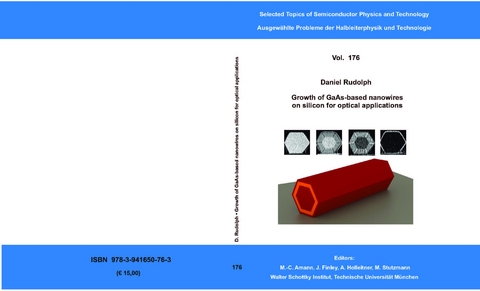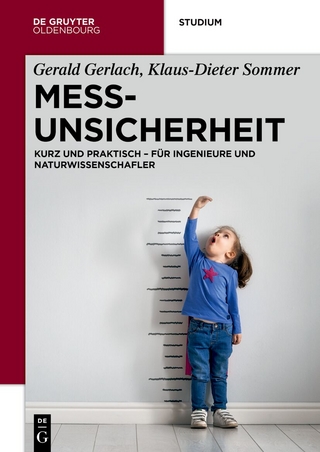Growth of GaAs-based nanowires on silicon for optical applications
Seiten
2014
Verein zur Förderung des Walter Schottky Instituts der Technischen Universität München (Verlag)
978-3-941650-76-3 (ISBN)
Verein zur Förderung des Walter Schottky Instituts der Technischen Universität München (Verlag)
978-3-941650-76-3 (ISBN)
- Keine Verlagsinformationen verfügbar
- Artikel merken
In this thesis, we investigate the integration of GaAs-based nanowires and their het- erostructures on Si using molecular beam epitaxy without external catalyst and further study their correlated microstructure-optical properties. Self-assembled GaAs nanowires are grown on Si(111) covered with an ultrathin (1–2 nm) layer of SiO2. This results in vertically [111]-oriented nanowires with a hexagonal cross-section formed by {110} side facets. The role of the oxide mask during nanowire growth is investigated using atomic force microscopy and in-situ quadrupole mass spectrometry, evidencing that nano-size pinholes in the SiO2 mask are necessary for successful nanowire nucleation.
We systematically investigate morphology, crystal structure and optical properties of as-grown GaAs nanowires as a function of supplied As flux, revealing two distinct growth regimes dependent on the prevalent As/Ga flux ratio; (i) an As-limited growth regime, where nanowire growth is governed by a Ga-catalyzed vapor-liquid-solid (VLS) growth mechanism and which results in nanowires of high aspect ratio and predominantly zincblende crystal structure, and (ii) a Ga-limited growth regime, where growth takes place via a non-VLS growth mechanism that results in shorter nanowires with a high density of planar defects. The presence or absence of Ga droplets during nanowire growth is confirmed by in-situ nucleation studies using reflection high energy electron diffraction. Single nanowire photoluminescence (PL) spectroscopy reveals a strong cor- relation between optical nanowire properties and microstructure; crystal phase mixture and planar twin defects lead to a red-shifted PL band stemming from the recombination of indirect excitons forming in zincblende/wurtzite heterostructures due to the type-II band alignment. We further realize GaAs nanowires in the quantum confinement regime with diameters < 15 nm by post-growth thermal annealing of VLS-grown nanowires.
In addition to self-organized nanowire growth, we demonstrate site-selective growth of autocatalytic GaAs nanowires on nano-patterned SiO2/Si(111) growth templates, pre- pared by either electron beam lithography or nanoimprint lithography. The nanowire yield (i.e., vertically oriented nanowire per predefined mask opening) is found to depend sensitively on template design, growth parameters and pre-growth conditions. In particu-
lar, we identify a small window of growth temperatures (T ∼ 615 ◦C) and As/Ga ratios (∼ 2.0) for site-selective nanowire growth with reasonable growth selectivity and nano-
wire yield. Under so far optimized growth conditions and template design, we achieve a nanowire yield of 35 ± 2 %. Systematic investigations of the nanowire morphology as a
function of interwire distance (pitch) allow us to obtain a deeper understanding of the underlying growth kinetics. We identify two distinct growth regimes; (i) a competitive regime for small pitches and (ii) a diffusion-limited regime for pitches larger than the Ga diffusion length.
Furthermore, we investigate growth of GaAs-AlGaAs core-shell nanowires on Si. The composition of the AlGaAs shell is studied using spatially resolved Raman spectroscopy, attesting good average alloy homogeneity along the nanowire axis. However, using cross- sectional high resolution scanning transmission electron microscopy, we identify alloy segregation and inhomogeneities in the radial direction. In particular, six Al-rich layers with Al content twice as high as in the bulk AlGaAs shell are observed at the intersection of adjacent {110} sidewall facets, as evident from X-ray energy dispersive spectroscopy.
This Al enrichment is associated with capillary group-III diffusion owing to the non- planar nanostructure geometry. Passivation of GaAs nanowires with an AlGaAs shell is shown to cause a strong 103-fold enhancement of the radiative efficiency via suppression of non-radiative surface recombination. Moreover, we observe a broadened band of sharp- line PL features extending 30–150 meV below the band gap of AlGaAs, attributed to excitons localized to point defects and alloy fluctuations in the AlGaAs shell.
In further experiments, we study individual core-shell nanowires using temperature de- pendent time-resolved PL spectroscopy to elucidate the trapping and thermal activation dynamics of excitons bound to isolated twin defects. Comparison of the time-resolved PL spectra with a two-level rate equation model allows us to deduce quantitative in- formation about exciton trapping and detrapping rates. For T = 6 K the dynamics
are dominated by rapid exciton trapping within ∼ 50 ps. However, upon increasing the
temperature to 20 K, the detrapping rate is found to increase according to a thermal activation energy of EA = 5.8 ± 1.0 meV. This value indicates that bound excitons are
thermally activated directly into the free exciton continuum without the need to over- come an additional energetic barrier.
Finally, we establish and characterize GaAs-AlGaAs core-multishell nanowires on Si and demonstrate spectral tunability of the PL emission via quantum confinement in radial GaAs quantum wells.
We systematically investigate morphology, crystal structure and optical properties of as-grown GaAs nanowires as a function of supplied As flux, revealing two distinct growth regimes dependent on the prevalent As/Ga flux ratio; (i) an As-limited growth regime, where nanowire growth is governed by a Ga-catalyzed vapor-liquid-solid (VLS) growth mechanism and which results in nanowires of high aspect ratio and predominantly zincblende crystal structure, and (ii) a Ga-limited growth regime, where growth takes place via a non-VLS growth mechanism that results in shorter nanowires with a high density of planar defects. The presence or absence of Ga droplets during nanowire growth is confirmed by in-situ nucleation studies using reflection high energy electron diffraction. Single nanowire photoluminescence (PL) spectroscopy reveals a strong cor- relation between optical nanowire properties and microstructure; crystal phase mixture and planar twin defects lead to a red-shifted PL band stemming from the recombination of indirect excitons forming in zincblende/wurtzite heterostructures due to the type-II band alignment. We further realize GaAs nanowires in the quantum confinement regime with diameters < 15 nm by post-growth thermal annealing of VLS-grown nanowires.
In addition to self-organized nanowire growth, we demonstrate site-selective growth of autocatalytic GaAs nanowires on nano-patterned SiO2/Si(111) growth templates, pre- pared by either electron beam lithography or nanoimprint lithography. The nanowire yield (i.e., vertically oriented nanowire per predefined mask opening) is found to depend sensitively on template design, growth parameters and pre-growth conditions. In particu-
lar, we identify a small window of growth temperatures (T ∼ 615 ◦C) and As/Ga ratios (∼ 2.0) for site-selective nanowire growth with reasonable growth selectivity and nano-
wire yield. Under so far optimized growth conditions and template design, we achieve a nanowire yield of 35 ± 2 %. Systematic investigations of the nanowire morphology as a
function of interwire distance (pitch) allow us to obtain a deeper understanding of the underlying growth kinetics. We identify two distinct growth regimes; (i) a competitive regime for small pitches and (ii) a diffusion-limited regime for pitches larger than the Ga diffusion length.
Furthermore, we investigate growth of GaAs-AlGaAs core-shell nanowires on Si. The composition of the AlGaAs shell is studied using spatially resolved Raman spectroscopy, attesting good average alloy homogeneity along the nanowire axis. However, using cross- sectional high resolution scanning transmission electron microscopy, we identify alloy segregation and inhomogeneities in the radial direction. In particular, six Al-rich layers with Al content twice as high as in the bulk AlGaAs shell are observed at the intersection of adjacent {110} sidewall facets, as evident from X-ray energy dispersive spectroscopy.
This Al enrichment is associated with capillary group-III diffusion owing to the non- planar nanostructure geometry. Passivation of GaAs nanowires with an AlGaAs shell is shown to cause a strong 103-fold enhancement of the radiative efficiency via suppression of non-radiative surface recombination. Moreover, we observe a broadened band of sharp- line PL features extending 30–150 meV below the band gap of AlGaAs, attributed to excitons localized to point defects and alloy fluctuations in the AlGaAs shell.
In further experiments, we study individual core-shell nanowires using temperature de- pendent time-resolved PL spectroscopy to elucidate the trapping and thermal activation dynamics of excitons bound to isolated twin defects. Comparison of the time-resolved PL spectra with a two-level rate equation model allows us to deduce quantitative in- formation about exciton trapping and detrapping rates. For T = 6 K the dynamics
are dominated by rapid exciton trapping within ∼ 50 ps. However, upon increasing the
temperature to 20 K, the detrapping rate is found to increase according to a thermal activation energy of EA = 5.8 ± 1.0 meV. This value indicates that bound excitons are
thermally activated directly into the free exciton continuum without the need to over- come an additional energetic barrier.
Finally, we establish and characterize GaAs-AlGaAs core-multishell nanowires on Si and demonstrate spectral tunability of the PL emission via quantum confinement in radial GaAs quantum wells.
| Verlagsort | Garching |
|---|---|
| Sprache | englisch |
| Einbandart | Paperback |
| Themenwelt | Naturwissenschaften ► Physik / Astronomie |
| Schlagworte | GaAs nanowire growth • Nanoimprint Lithography • optical properties |
| ISBN-10 | 3-941650-76-9 / 3941650769 |
| ISBN-13 | 978-3-941650-76-3 / 9783941650763 |
| Zustand | Neuware |
| Haben Sie eine Frage zum Produkt? |
Mehr entdecken
aus dem Bereich
aus dem Bereich
von den Werkzeugen über Methoden zum TQM
Buch | Softcover (2024)
Springer Fachmedien (Verlag)
32,99 €
kurz und praktisch - für Ingenieure und Naturwissenschafler
Buch | Softcover (2024)
De Gruyter Oldenbourg (Verlag)
44,95 €




